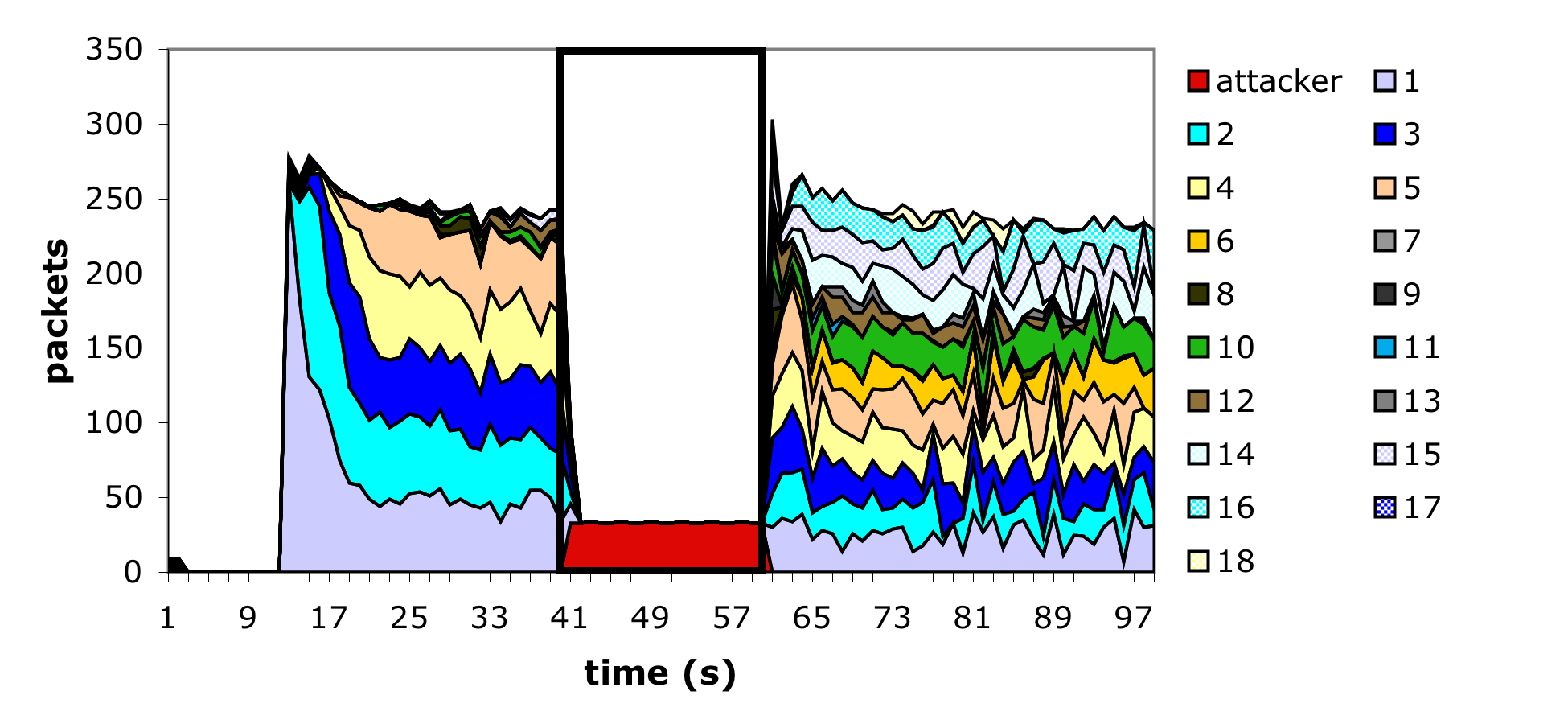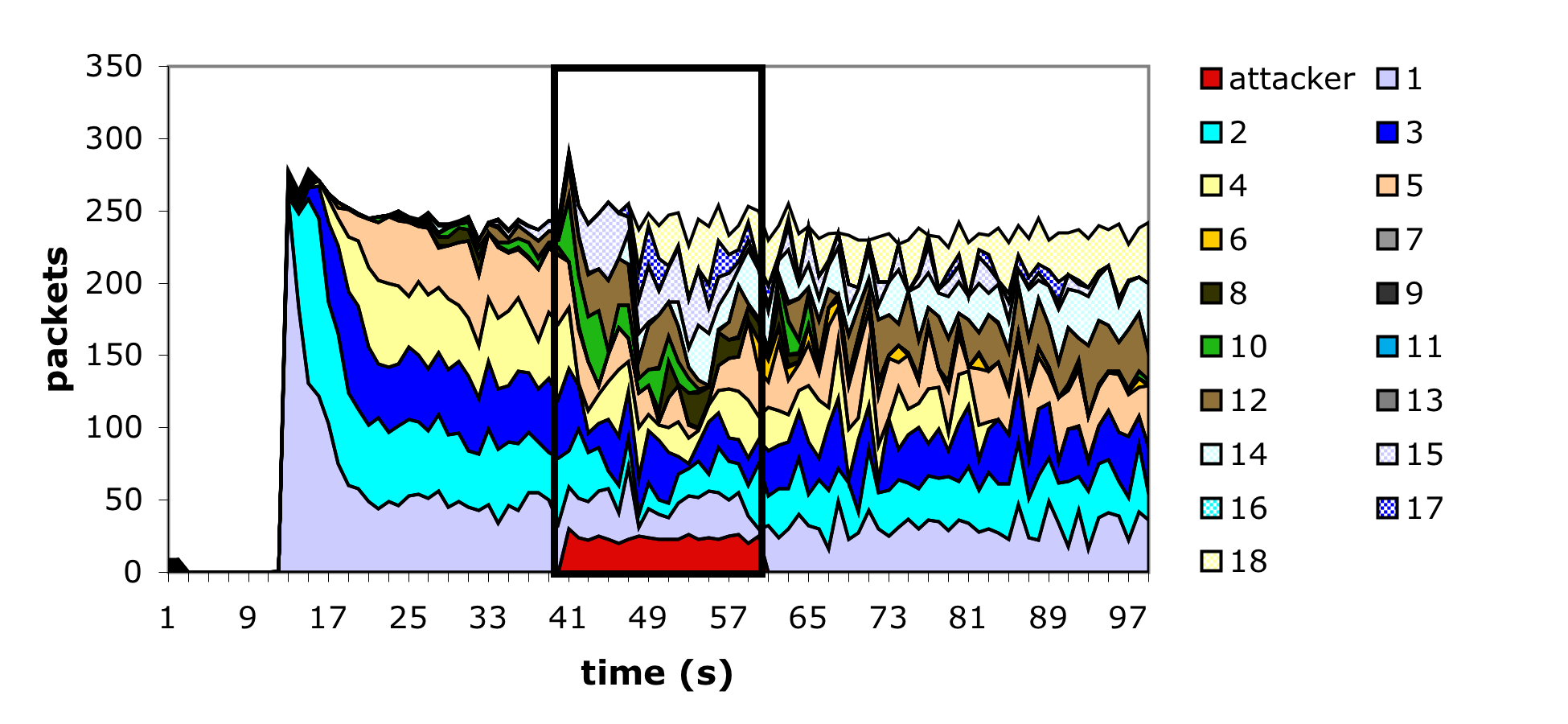
|
Under the assumption that these bugs will be removed in future 802.11 products (since they effectively prevent RTS/CTS from working as well as the 802.11 Point Coordinator Function and all related Quality-of-Service services based on 802.11) the remainder of this section explores the NAV vulnerability in the context of the popular ns simulator (which implements the protocol faithfully).
We implemented the virtual carrier-sense attack by modifying the ns [NS] 802.11 MAC layer implementation to allow arbitrary duration values to be sent periodically, 30 times a second, by the attacker. The attacker's frames were sent using the normal 802.11 access timing restrictions, which was necessary to prevent the attacker from excessively colliding with other in-flight frames (and thereby increase the amount of work required of the attacker). In addition the attacker was modified to ignore all duration values transmitted from any other node. The network topology was chosen to mimic many existing 802.11 infrastructure deployments: a single access point node, through who all traffic was being sent, 18 static client nodes and 1 static attacker node, all within radio distance of the access point. As with the previous experiments, ftp was used to generate the long-lived network traffic. We simulated attacks using ACK frames with large duration values, as well as the RTS/CTS sequence described earlier. Figure 8 shows the ACK flavor of the virtual carrier-sense attack in action, but both provided similar results: the channel is completely blocked for the duration of the attack.

|
We modified our simulation to add these limits, assuming that a value of 1500 bytes as the largest packet. While this is not strictly the largest packet that can be sent in an 802.11 network, it is the largest packet sent in practice because 802.11 networks are typically bridged to Ethernet, which has a roughly 1500 byte MTU. Figure 9 shows a simulation of this defense under the same conditions as the prior simulation. While there is still significant perturbation, many of the individual sessions are able to make successful forward progress. However, we found that simply by increasing the attacker's frequency to 90 packets per second, the network could still be shut down. This occurs because the attacker is using ACK frames, whose impact on the NAV is limited by the high cap.
To further improve upon this result requires us to abandon portions of the standard 802.11 MAC functionality. At issue is the inherent trust that nodes place in the duration value sent by other nodes. By considering the different frame types that carry duration values we can define a new interpretation of the duration that allows us to avoid most possible DoS attacks. The four key frame types that contain duration values are ACK, data, RTS, and CTS, and we consider each in turn.
Under normal circumstances the only time a ACK frame should carry a large duration value is when the ACK is part of a fragmented packet sequence. In this case the ACK is reserving the medium for the next fragment. If fragmentation is not used then there is no reason to respect the duration value contained in ACK frames. Since fragmentation is almost never used (largely due to the fact that default fragmentation thresholds significantly exceed the Ethernet MTU) removing it from operation altogether will have minimal impact on existing networks.
Like the ACK frame, the only legitimate occasion a data frame can carry a large duration value is if it is a subframe in a fragmented packet exchange. Since we have removed fragmentation from the network, we can safely ignore the duration values in all data frames.

|
The last frame to consider is the CTS frame. If a lone CTS frame is observed there are two possibilities: the CTS frame was unsolicited or the observing node is a hidden terminal. These are the only two cases possible, since if the observing node was not a hidden terminal it would have heard the original RTS frame and it would be handled accordingly. If the unsolicited CTS is addressed to a valid, in-range node, then only the valid node knows the CTS is bogus. It can prevent this attack by responding to such a CTS with a null function packet containing a zero duration value - effectively undoing the attackers channel reservation. However, if an unsolicited CTS is addressed to a nonexistent node, or a node out of radio range, this is indistinguishable from a legitimate hidden terminal. In this case, there is insufficient information for a legitimate node to act. The node issuing the CTS could be an attacker, or they may simply be responding to a legitimate RTS request that is beyond the radio range of the observer.
An imperfect approach to this final situation, is to allow each node to independently choose to ignore lone CTS packets as the fraction of time stalled on such requests increases. Since hidden terminals are a not a significant efficiency problem in most networks (as evidenced by the fact that RTS/CTS are rarely employed and since the underlying functionality does not seem to work in many implementations) setting this threshold at 30 percent, will provide normal operation in most legitimate environments, but will prevent an attacker from claiming more than a third of the bandwidth using this attack.
It should also be noted that existing 802.11 implementations use different receive and carrier-sense thresholds. The different values are such that, in an open area, the interference radius of a node is approximately double its transmit radius. In the hidden terminal case this means that although the hidden terminal can not receive the data being transmitted, it still detects a busy medium and will not generate any traffic that would interfere with the data, so the possibility of an unsolicited CTS followed by an undetectable data packet is very low.
But ultimately the only foolproof solution to this problem is to extend explicit authentication to 802.11 control packets. Each client-generated CTS packet contains an implicit claim that it was sent in response to a legitimate RTS generated by an access point. However, to prove this claim, the CTS frame must contain a fresh and cryptographically signed copy of the originating RTS. If every client shares keying material with all surrounding access points it is then possible to authenticate lone CTS requests directly. However, such a modification is a significant alternation to the existing 802.11 standard, and it is unclear if it offers sufficient benefits relative to its costs. In the meantime, the system-level defenses we have described provide reasonable degrees of protection with extremely low implementation overhead and no management burden. Should media-access based denial-of-service attacks become prevalent, these solutions could be deployed quickly with little effort.
John Bellado 2003-05-16